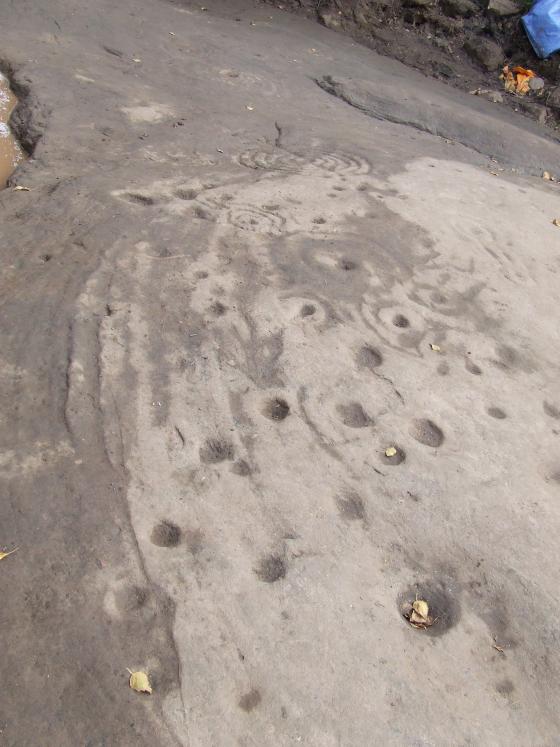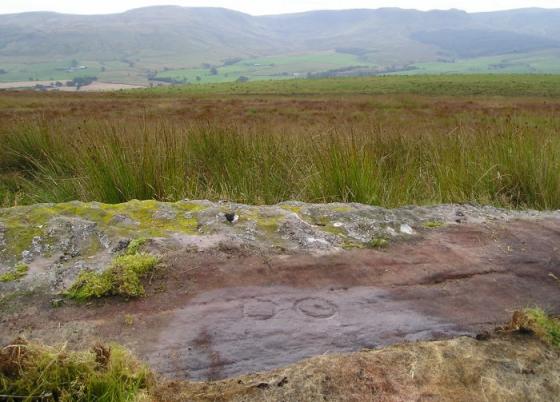




The gentlemen of the Maryhill Temperance Society on an outing to the Auld Wives Lifts in 1888. From a Glasgow Temperance League postcard.

From A D Robertson’s ‘Druidical Altar, Craigmaddie, Parish of Baldernock, Stirlingshire’, in the Transactions of the Glasgow Archaeological Society v2, 1883.

Me on top to give an idea of the scale of this feature.

‘Fairy footprint’ carvings near the Auld wives Lifts. Close by there is evidence of quarrying for millstones, so I’m guessing some bored workers created these tiny footprints?

Another view of the Lifts.

Another stone from the triangular formation east of the Lifts.

This standing stone is situated a couple of hundred yards to the east of the Lifts. There are two more forming a triangular formation.

Another ‘head’.

The ‘eye’ adjacent to the Auld Wives Lifts.

One of several carved ‘heads’ on the Auld Wives Lifts.


The Auld Wives Lifts on the Craigmaddie Muir near Milngavie.
The Auld Wives Lifts sit in a natural amphitheatre on the Cragmaddie Muir above Milngavie near Glasgow.
They consist of three extremely large pieces of grey schist, one propped on top of the other two. There is a space between them through which it is possible to pass.
The rocks are covered in carved grafitti from as far back as the 18th century at least, as well as around eight or so carved ‘heads’ or ‘faces’. These have a primeval look about them but are probably fairly recent. The surrounding rocks have several cup and ring marks as well as other markings (including an ‘eye’).
This mysterious and imposing monument of a prehistoric era is commonly known by the name of “The Three Auld Wives’ Lift” [..]
On the upper surface of the top stone of this structure, which is a plane declining a little to the south, there is sculptured a circle of thirty-six inches in diameter, [..] and strange as it may seem, notwithstanding the hundreds that visit this curious relic every year, and for as often as it has been described by archaeologists, this is the first time, so far as I know, that this typical figure has ever been brought under notice [..] The greater part of the upper surface where this symbol occurs is much disfigured by roughtly cut initial letters, and names of thoughtless visitors, rendering it less observable than it would otherwise be [..] To the experienced eye, its purpose-like execution, and weather-worn aspect, will be sufficient evidence of its great age and significance.
Between the upper and the two lower stones of this monument there is a triangular opening from east to west which, if passed through according to the course of the sun in a truly penitential spirit, was formerly believed to have procured complete absolution for previous sins, and superstition still holds it necessary for all strangers visiting this enchanted place for the first time to creep through it if they wish to avert the calamity of dying childless.*
[..] The traditional account of this monument is, that three old women having laid a wager which of them would carry the greatest burthen, brought in their aprons the three stones of which it is constructed, and laid them in their present position. Verily, there must have been giantesses in those days.
*Or you could just stay sinful and childless, yay!
From A D Robertson’s rather long-winded account in the Transactions of the Glasgow Archaeological Society (vol 2, 1883).
archive.org/stream/transactions11socigoog#page/n19/mode/1up
(while you’re about it, you may not want to miss the ghastly account of Oliver Cromwell’s preserved head, also in the same volume. or maybe you would.)
In Tom Weir’s Scotland the famous mountaineer and walker gives the legend in the chapter, on page 49, entitled:
Craigmaddie: The Secrets of the Muir
“The folk tale is that three witches wagered each other as to who could carry the heaviest stone in their aprons. Two managed to put their stones down side by side, but the third one capped their efforts by placing her larger stone on top of the other two in the form of a roof. A variation of the same tale is that it was a trial of strength to see who could throw a stone the farthest, and the biggest landed on top of the other two.”
He also mentions Hugh MacDonalds book “Rambles Around Glasgow” giving his 19th century beliefs.
“By some this gigantic cromlech is supposed to be a Druidical altar, whereon, in a dim prehistoric era, the dark rites of pagan worship may have been celebrated”. On an old map it was shown as a “Druidical Cromlech,” and the cavity between the stones was thought to be for the reception of human remains after blood sacrifices.
Weir goes on to say that he noticed initials and dates at first. The next day he was startled to find 8 carved heads that he didn’t notice the previous day. His good friend Prof. Alcock, of Glasgow University said that even his students had missed the faces. He then continued:
“I think it’s not beyond the bounds of possibility that the capstone was placed on top of the two smaller stones by the Celtic people who carved those heads. The vertical lift is not a big one , and it could have been done with wooden rollers”
Weir asked if the people who erected the stones worshipped at it. The professor answered:
“I think we could call them people under Roman influence. The carvings recall the severed heads of Gaul-one of the leading images of the Celtic religion. Notice too, that the heads are confined to the east and north, while the two most arresting of them look out from the north-eastern and south-eastern edges. That would be a remarkable coincidence if the heads were the work of casual visitors.”
To be fair to Weir he gets independent views from Dr. Rolf and Dr. Ingham of Glasgow University. “They were in no doubt that the stones were of a glacial origin, but beyond that they were not prepared to speculate.”
First published in 1980.
Apparently not just for fertility:
On Craigmaddie Muir stnads the Cromlech, or Sepulchral-Trilith, popularly called “The Auld Wives’ Lift,” and ivested with some curious traditions and customs. It consists of three huge stones, two of which support the third. The uppermost is an enormous block of basalt, measuring rather more than 18 feet in length, by 11 feet in breadth and 7 in depth. A small triangular space occurs between the stones, and through this, tradition recommends all visitors to pass, desirous not to be childless, and to be safe from the pranks of the Evil One.
In ‘Glasgow Past and Present’ by James Pagan (1856). Online at Google Books.
F.R. Coles wrote this about the stones in 1906
“Auld Wives’ Lifts belong, in the megalithic folk-lore, to the section which comprises legends of women, or witches, or carlines, who transport through the air masses of stone, great or small, and here and there drop them ; thus forming cairns, groups of standing stones, or single groups of enormous blocks, like the pierres levies
‘at Poictiers and other French localities. This remarkable group on Craigmaddie Muir has also associations with another phase of superstition ; for Mr Robertson observes that it is ” still necessary for all strangers visiting this enchanted place for the first time, to creep through it, if they wish to avert the calamity of dying childless.” He notes the old spelling was Craig-madden, and translates madden as
= moid/lean, entreaty, supplication : The rock of prayer.”
This correspondent in Notes and Queries is using the ‘Philosophical Survey of the South of Ireland, in a Series of Letters to John Watkinson, M.D., 8vo., Dublin, 1778.’ as his source.
About ten miles north of Glasgow, near the village of Strathblane, were to be seen till lately (as I am informed, some sordid Goth having broken them up to build walls) three immense blocks of freestone in a remote field, reputed to be Druidical, which went under the name of the ” Auld Wives’ Lifts.”
Two of the stones lay together, and the third transversal on the top, with an aperture to creep through, by the doing or not doing of which strange rewards and penalties were the consequence. There is no similar kind of rock near the place. The surrounding ground is generally cold and infertile, and could not be said to be favourable for the growth of oaks or other trees ; but there are evidences from the extensive peat mosses and beams of black oak dug up, that in ancient times, in the neighbourhood of these stones, there had existed large forests of oak, supposed by some to bave been destroyed by the Romans who had possession of the spot, or by the Caledonians in their struggles with that power. G. N.
N&Q April 9th 1859. ‘Some sordid Goth’ – now that’s a great turn of phrase.
The Auld Wifes Lift as “North Blochairn” on BRAC
A nice little webpage on the rocks and the carvings which also features a beautiful old photograph of what appears to be a gentlemens outing.























